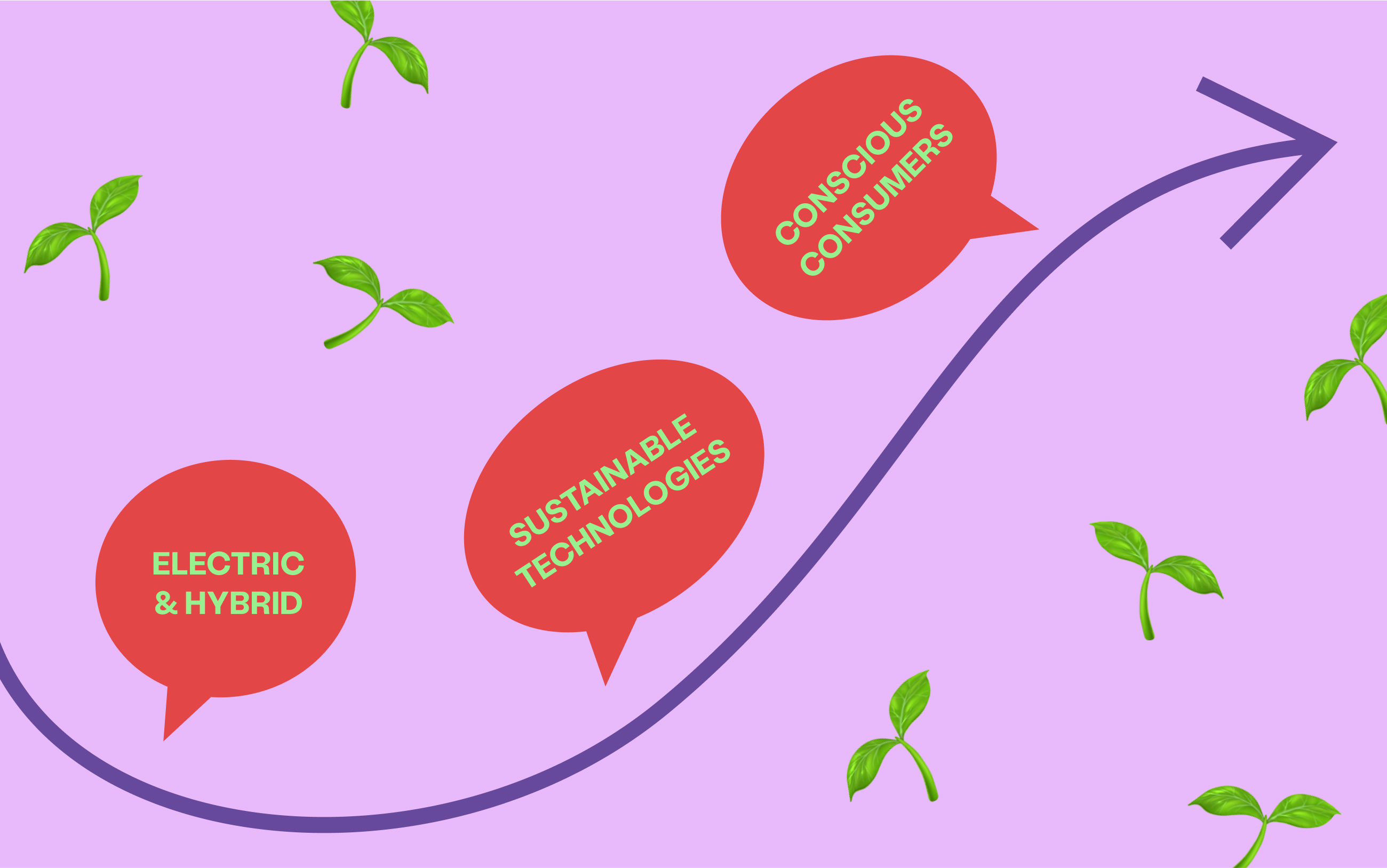Green car marketing is a crucial part of business strategies. Find out what the challenges are for low-emission vehicles.


Index
- Electrification and hybridization
- Growing consumer awareness
- Challenges in marketing green cars
- Perception of high costs
- Limited charging infrastructure
- Lack of technological awareness
- Competition with traditional vehicles
- Communication of environmental benefits
- Events to raise awareness of green issues
- Strategic collaborations with green partners
- Sustainable driving experiences
- Content marketing
- Public relations
The automotive industry is undergoing an unprecedented transformation with the increasing emphasis on green cars, powered by sustainable energy sources. This trend reflects the growing environmental awareness of consumers and the need to reduce greenhouse gas emissions. As part of this shift, green car marketing has become a crucial part of automakers' corporate strategies.
The future of mobility and the automotive industry is increasingly green, smart and connected. According to a study by Deloitte, 69% of Italians would prefer an electric or hybrid vehicle over a traditional one. Most of those in favor of a green vehicle are driven by a desire to reduce environmental impact, followed by consideration of lower power costs.

In recent decades, sustainable marketing has taken on a crucial role as growing awareness of massive waste, consumption and pollution has required a change in the behaviors of both consumers and companies. The latter have been pushed to take active steps to develop and implement more sustainable practices at the level of automobile production and distribution.
This transition will have significant impacts on various aspects of corporate and individual life, bringing benefits such as creating a competitive advantage for those who adopt it and, even more importantly, contributing to community and environmental well-being.
Trends in the green automotive sector

Marketing campaigns need to highlight the positive environmental impacts of using green cars, such as reducing greenhouse gas emissions and air pollution.
Electrification and hybridization
One of the most obvious trends is the accelerated electrification of cars. Automakers are investing heavily in the development of electric vehicles (EVs) and plug-in hybrids. Growing charging infrastructure and government incentives are helping to make EVs more affordable and attractive to consumers.
Development of sustainable technologies
Automakers are focusing their efforts on researching and developing sustainable technologies to reduce environmental impact. This includes the use of lightweight materials, more efficient batteries and advanced recycling systems. These innovations not only help improve the performance of cars, but also demonstrate the brand's commitment to sustainability.
Changing one's business models in the automotive industry can occur through the adoption of the circular economy. This involves innovating business models, cutting material and resource costs, and promoting product durability and sharing. In addition, product life can be extended by recovering and reconditioning used components, and recycling and reusing high-quality materials.
Adoption of the circular economy in the automotive sector can reduce waste, promote environmental sustainability, and provide economic benefits to companies.
Growing consumer awareness
Consumers are becoming increasingly aware of the environmental impact of their automobile purchasing choices. Growing environmental awareness has led to increased demand for low-emission vehicles, prompting automakers to shift their production toward more environmentally friendly models.
The boom in electric and hybrid cars is one sign of this shift, along with the ever-lower cost of batteries. Reducing waste and sharing cars are important to achieving circular economy goals in the automotive sector.
Challenges in marketing green cars
Challenges in marketing green cars are a crucial element to be addressed in today's sustainability-oriented automotive environment. These challenges can influence consumer perceptions, the diffusion of new technologies, and market growth. Below, we will look at some of the main challenges in marketing green cars.
Perception of high costs
One of the most significant challenges is the widespread perception that green cars are more expensive than traditional internal combustion vehicles. Despite government incentives and long-term operating cost savings, many consumers may be reluctant to invest in a green vehicle because of a higher initial price than conventional models.
Marketing must therefore focus on communicating these long-term benefits to disprove the notion that sustainability is synonymous with higher costs.

Limited charging infrastructure
Another key challenge is the lack of adequate charging infrastructure. The fear of limited range and the difficulty in finding charging stations can discourage potential buyers. Automakers need to address this challenge by partnering with charging service providers and investing in building a network of affordable and accessible charging stations.

Lack of technological awareness
Many consumers may not be fully informed about the technical features of low-emission vehicles and the benefits they offer. Lack of technological awareness can hinder the adoption of green cars. Marketing should strive to educate consumers through information campaigns that clearly and accessibly explain the sustainable technologies used in green vehicles and the associated environmental benefits.

Competition with traditional vehicles
Competition with traditional fossil-fueled vehicles presents another challenge for marketing green cars. Many consumers may be reluctant to make the transition to green vehicles because of the proven reliability and widespread presence of traditional vehicles in the market. Marketing must focus on highlighting the performance, reliability, and advanced technology of green vehicles to bring out their competitiveness against their traditional counterparts.

Communication strategies in green car marketing
Green storytelling
One of the most effective strategies for promoting green automotive technologies is to tell sustainability stories that highlight the company's efforts in reducing its environmental impact. Communication strategies should focus on building a positive and compelling narrative, highlighting both the ecological and economic aspects of green vehicles. Automakers often communicate their progress through advertising campaigns, green storytelling campaigns to emphasize the benefits of green strategies, social media content, and press releases that emphasize their commitment to a greener future.
Communication of environmental benefits
Automakers should focus on environmental benefits, such as reducing greenhouse gas emissions, increasing fuel efficiency, and reducing air pollution. Engaging influencers in targeted promotion strategies allows them to share positive experiences with green cars and promote the sustainability message.

Events to raise awareness of green issues
Actively engaging consumers is critical in marketing green cars. Companies hold events, webinars, and outreach activities to educate consumers about the features and benefits of low-emission vehicles.
Direct interaction helps to dispel doubts and promote a deeper understanding of sustainable technologies. We can organize webinars or online events to discuss the benefits of green cars, engaging industry experts, engineers or marketers to answer questions from potential buyers.
Strategic collaborations with green partners
Automakers often establish strategic partnerships with companies active in renewable energy or sustainability. These partnerships help solidify the image of a company committed to reducing its environmental impact and can generate mutually beneficial synergies. This helps solidify the brand's credibility and green reputation.
Sustainable driving experiences
Offering sustainable driving experiences is a key element in convincing consumers to switch to low-emission vehicles. Companies organize test drives, trial events, and demonstrations to allow potential buyers to experience firsthand the performance and reliability of green vehicles.
Offer test drive sessions to allow potential buyers to directly experience the performance and drive of green cars. This can help dispel any doubts and encourage interest.
Content marketing
Content marketing, such as blogs, videos, and podcasts, is an effective way to educate consumers about low-emission vehicles. Automakers can use content marketing to provide information about the environmental benefits of low-emission vehicles, as well as vehicle features and performance.

Public relations
Public relations can be used to generate positive media coverage about low-emission vehicles. Automakers can use public relations to announce new low-emission vehicles, to highlight environmental features of vehicles, or to address consumer concerns.
Green car marketing - Conclusions
Green car marketing has become a crucial strategy in today's sustainability-driven automotive landscape. Communication strategies face challenges such as perceived high costs and lack of charging infrastructure, but can be addressed through a combination of sustainability stories, consumer engagement, and strategic partnerships.
Through innovation and ongoing engagement, the green automotive sector can lead the way toward a more sustainable future.